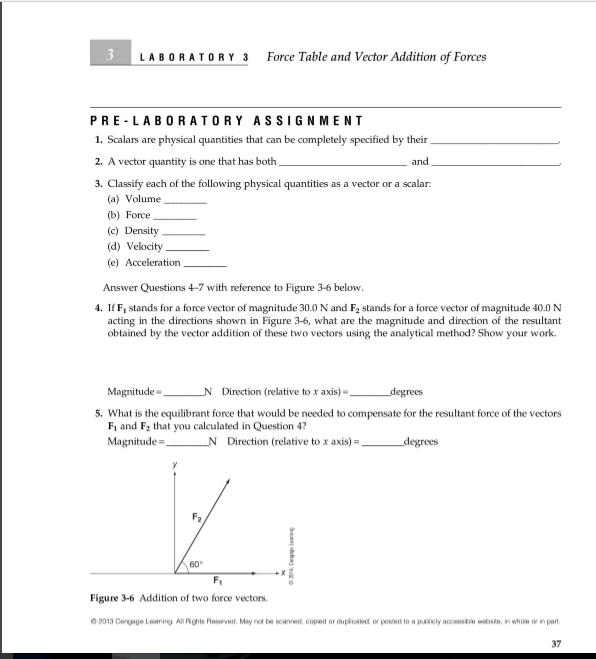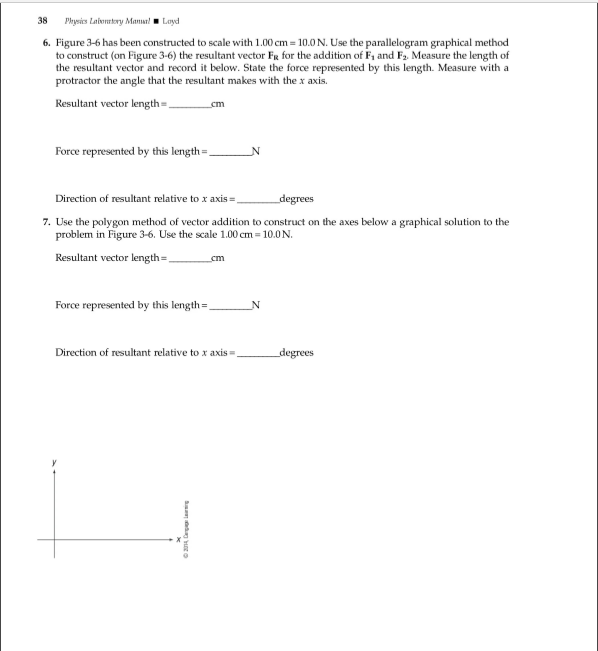3 LA BORATORY 3 Force Table and Vector Addition of Forces PRE-LABORATORY AS SIG NMENT 1. Scalars are physical quantities that can be completely specified by their агe and 2. A vector quantity is one that has both 3. Classify each of the following physical quantities as a vector or a scalar (a) Volume (b) Force (c) Density (d) Velocity (e) Acceleration Answer Questions 4-7 with reference to Figure 3-6 below 4. If Fi stands for a force vector of magnitude 30.0 N and Fa stands for a force vector of magnitude 40.0 N acting in the directions shown in Figure 3-6, what are the magnitude and direction of the resultant obtained by the vector addition of these two vectors using the analytical method? Show your work Direction (relative to x axis)-. _degrees Magnitude N 5. What is the equilibrant force that would be needed to compensate for the resultant force of the vectors F1 and F2 that you calculated in Question 4? Magnitude N Direction (relative to x axis). _degrees F2 60 F1 Figure 3-6 Addition of two force vectors 2013 Cengage Leaming All Rghts Reserved. May not be scanned, coped or dupicated or posed to a publicly acceesbe webste, in whole or in part 38 Physics Lalonry ManuLayd 6. Figure 3-6 has been constructed to scale with 1.00 cm 10.0 N. Use the parallelogram graphical method to construct (on Figure 3-6) the resultant vector Fg for the additionn of F1 and F2 Measure the length of the resultant vector and record it below. State the force represented by this length. Measure with a protractor the angle that the resultant makes with the x axis. Resultant vector length=, cm Force represented by this length=_ N Direction of resultant relative to x axis=, degrees 7. Use the polygon method of vector addition to construct on the axes below a graphical solution to the problem in Figure 3-6. Use the scale 1.00 cm 10.0N Resultant vector length=, cm Force represented by this length N Direction of resultant relative to x axis. degrees
3 LA BORATORY 3 Force Table and Vector Addition of Forces PRE-LABORATORY AS SIG NMENT 1. Scalars are physical quantities that can be completely specified by their агe and 2. A vector quantity is one that has both 3. Classify each of the following physical quantities as a vector or a scalar (a) Volume (b) Force (c) Density (d) Velocity (e) Acceleration Answer Questions 4-7 with reference to Figure 3-6 below 4. If Fi stands for a force vector of magnitude 30.0 N and Fa stands for a force vector of magnitude 40.0 N acting in the directions shown in Figure 3-6, what are the magnitude and direction of the resultant obtained by the vector addition of these two vectors using the analytical method? Show your work Direction (relative to x axis)-. _degrees Magnitude N 5. What is the equilibrant force that would be needed to compensate for the resultant force of the vectors F1 and F2 that you calculated in Question 4? Magnitude N Direction (relative to x axis). _degrees F2 60 F1 Figure 3-6 Addition of two force vectors 2013 Cengage Leaming All Rghts Reserved. May not be scanned, coped or dupicated or posed to a publicly acceesbe webste, in whole or in part 38 Physics Lalonry ManuLayd 6. Figure 3-6 has been constructed to scale with 1.00 cm 10.0 N. Use the parallelogram graphical method to construct (on Figure 3-6) the resultant vector Fg for the additionn of F1 and F2 Measure the length of the resultant vector and record it below. State the force represented by this length. Measure with a protractor the angle that the resultant makes with the x axis. Resultant vector length=, cm Force represented by this length=_ N Direction of resultant relative to x axis=, degrees 7. Use the polygon method of vector addition to construct on the axes below a graphical solution to the problem in Figure 3-6. Use the scale 1.00 cm 10.0N Resultant vector length=, cm Force represented by this length N Direction of resultant relative to x axis. degrees
College Physics
1st Edition
ISBN:9781938168000
Author:Paul Peter Urone, Roger Hinrichs
Publisher:Paul Peter Urone, Roger Hinrichs
Chapter3: Two-dimensional Kinematics
Section: Chapter Questions
Problem 14PE: Find the following for path D in Figure 3.58: (a) the total distance traveled and (b) the magnitude...
Related questions
Question
Can you please do question number 6? Thank you.

Transcribed Image Text:3
LA BORATORY 3
Force Table and Vector Addition of Forces
PRE-LABORATORY AS SIG NMENT
1. Scalars are physical quantities that can be completely specified by their
агe
and
2. A vector quantity is one that has both
3. Classify each of the following physical quantities as a vector or a scalar
(a) Volume
(b) Force
(c) Density
(d) Velocity
(e) Acceleration
Answer Questions 4-7 with reference to Figure 3-6 below
4. If Fi stands for a force vector of magnitude 30.0 N and Fa stands for a force vector of magnitude 40.0 N
acting in the directions shown in Figure 3-6, what are the magnitude and direction of the resultant
obtained by the vector addition of these two vectors using the analytical method? Show your work
Direction (relative to x axis)-.
_degrees
Magnitude
N
5. What is the equilibrant force that would be needed to compensate for the resultant force of the vectors
F1 and F2 that you calculated in Question 4?
Magnitude
N Direction (relative to x axis).
_degrees
F2
60
F1
Figure 3-6 Addition of two force vectors
2013 Cengage Leaming All Rghts Reserved. May not be scanned, coped or dupicated or posed to a publicly acceesbe webste, in whole or in part

Transcribed Image Text:38
Physics Lalonry ManuLayd
6. Figure 3-6 has been constructed to scale with 1.00 cm 10.0 N. Use the parallelogram graphical method
to construct (on Figure 3-6) the resultant vector Fg for the additionn of F1 and F2 Measure the length of
the resultant vector and record it below. State the force represented by this length. Measure with a
protractor the angle that the resultant makes with the x axis.
Resultant vector length=,
cm
Force represented by this length=_
N
Direction of resultant relative to x axis=,
degrees
7. Use the polygon method of vector addition to construct on the axes below a graphical solution to the
problem in Figure 3-6. Use the scale 1.00 cm 10.0N
Resultant vector length=,
cm
Force represented by this length
N
Direction of resultant relative to x axis.
degrees
Expert Solution
This question has been solved!
Explore an expertly crafted, step-by-step solution for a thorough understanding of key concepts.
This is a popular solution!
Trending now
This is a popular solution!
Step by step
Solved in 2 steps with 1 images

Knowledge Booster
Learn more about
Need a deep-dive on the concept behind this application? Look no further. Learn more about this topic, physics and related others by exploring similar questions and additional content below.Recommended textbooks for you

College Physics
Physics
ISBN:
9781938168000
Author:
Paul Peter Urone, Roger Hinrichs
Publisher:
OpenStax College

Glencoe Physics: Principles and Problems, Student…
Physics
ISBN:
9780078807213
Author:
Paul W. Zitzewitz
Publisher:
Glencoe/McGraw-Hill


College Physics
Physics
ISBN:
9781938168000
Author:
Paul Peter Urone, Roger Hinrichs
Publisher:
OpenStax College

Glencoe Physics: Principles and Problems, Student…
Physics
ISBN:
9780078807213
Author:
Paul W. Zitzewitz
Publisher:
Glencoe/McGraw-Hill
